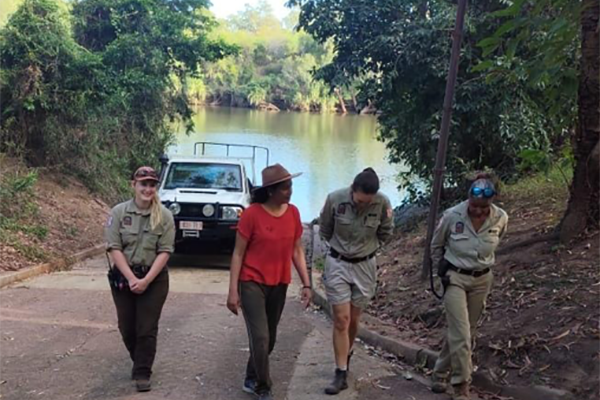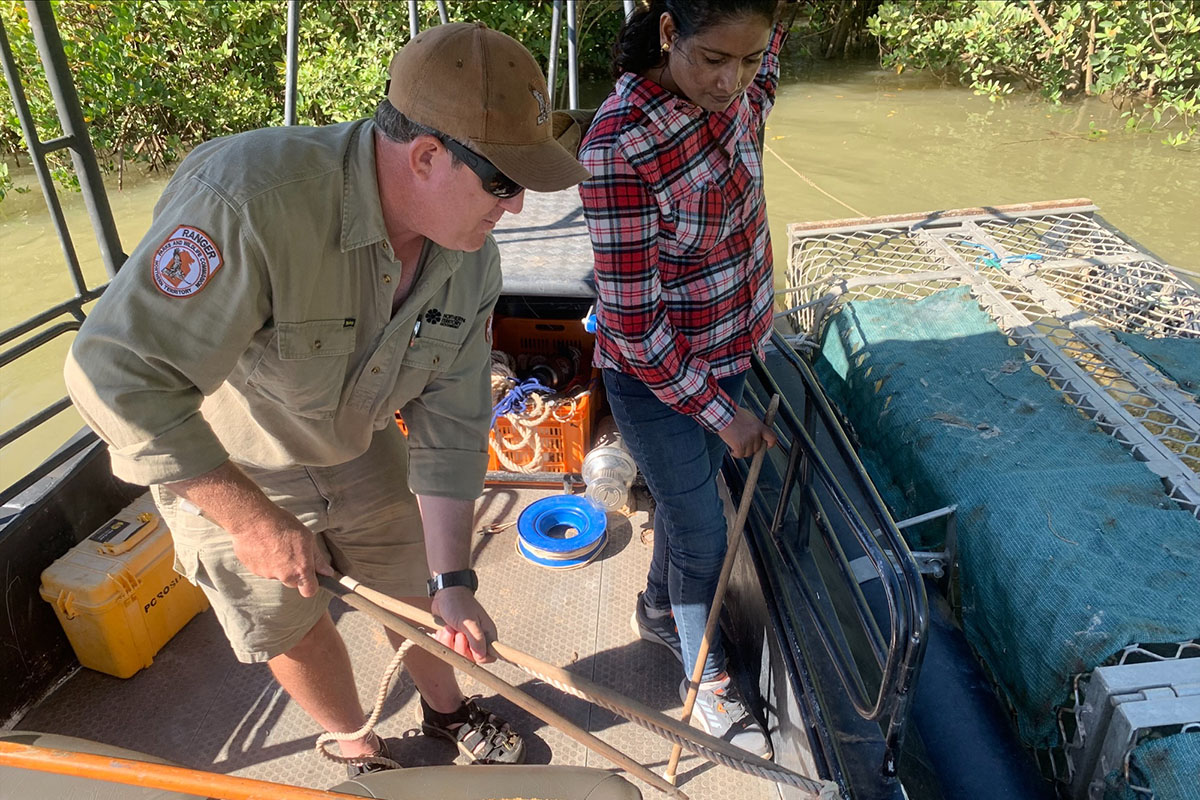Visiting Protected Area worker from India
Early this year the Northern Territory Ranger Association, with the support of the department, undertook peer-to-peer fundraising to bring a Ranger (assistant forester) to Australia from India to build capacity, share management techniques (especially for live crocodile capture), knowledge and ideas of the different ways of managing parks and reserves.
Prem Kunwar Shaktawat is a field-based, hands-on Ranger from Makundra Hill Tiger Reserve, located in Rajasthan in north western India. Her duties include monitoring, community outreach including employment, education on the importance of conservation reserves, enforcement and rescuing wildlife that leave the park and cause issues in the villages, roads and fields.
Prem loves her work at Makundra Hill Tiger Reserve and enjoys wildlife and photography. The reserve is part of a bigger plan to reintroduce tigers to the wild. There are 4 reserves in Rajasthan and Makundra Hill Tiger Reserve currently has 2 tigers, with plans for more to be introduced. There are many wildlife species in the reserve including leopards, honey badgers, hyena, pangolin, bird species including vultures and reptiles including the mugger (marsh) crocodile. The marsh crocodile is a freshwater crocodile but looks like a saltwater crocodile and the males can be over 3 m long. One of Prem’s duties is to rescue animals that leave the reserve and sometimes during flooding crocodiles find their way into villages, roads, irrigation channels and wells and they are caught and returned to the protected area. In India, the mugger crocodile is CITES 1 listed and cannot be traded and has full protection, unlike the CITES 2 listing of saltwater crocodiles in Australia that allows the sustainable use of the crocodile while maintaining good populations.
While attending the IUCN conference, held in April in Darwin, Prem presented a poster on the marsh crocodile and the work she has undertaken in her district. The international conference allowed her to meet and network with many crocodile experts from around the world, including those with similar species and issues she has in her district. She also met other crocodile researchers from India and Nepal who are now great contacts going forward.
Prem spent 2 weeks working with the Darwin crocodile management team as they managed the traps in the harbour and in other areas. Prem noted she would normally capture mugger crocodiles on land when they end up in a village or irrigation well, so the experience with the crocodile team was valuable in learning the techniques to restrain the crocodiles and safely handle them in water.
She was very interested in a drone demonstration of a baited wire snare to catch a crocodile in a body of water. Her current workplace does not use drones, but she could see the potential for the technique to be used from an overhanging tree or long pole. Unfortunately, no crocodiles were caught free hand during her time with the Darwin team. Prem is restricted in some of the techniques used in the NT, as the traps are not selective enough and meat bait will attract carnivores such as dogs or leopards. The Indian Government does not allow the use of harpoons due to injury to the crocodile. Department staff will provide examples of some of the other equipment and supplies used in the NT so she can try and source similar in India.
Prem’s last week was spent visiting Litchfield, Nitmiluk and Kakadu National Parks with a day behind the scenes of the Territory Wildlife Park (TWP). Prem was very interested in how the Parks are managed, the type of work that is done, how work programs are prepared, number of staff, and the management structure. There are many differences in the way parks and reserves are managed in the NT and India, yet many of the management issues are shared such as habitat loss, erosion, weeds, fire and poaching. It also became very apparent the wage disparity between the two countries and how expensive it is to live and work in Australia. In India, as part of the community inclusion and to assist with protection of the reserve, common tasks such as cleaning, gardening, path/road works, erosion dam walls, and building of water facilities for the wildlife are done by local labour from the villages.
The foresters’ duties include daily patrols for encroachment, enforcement, and wildlife monitoring. Tourism occurs on the Chambal River within the reserve by boat tours to nearby waterfalls. There is a core area that is for the Tiger breeding program only. Prem was curious why NT Rangers are cleaning toilets, mowing lawns, blowing paths and picking up rubbish and that this is not contracted out. Discussions were had about the cost of living and decisions made with limited budgets. It became very apparent that we do not do anywhere near the monitoring and patrolling that is done in the Indian reserves. Prem emphasised India strictly protects wildlife and the natural environment within the reserves from the immense human pressure.
Prem was impressed with some of the equipment the department has, like the side-by-side vehicles and litter pick up sticks. She was keen to see the setup of the TWP animal hospital facility. She really liked the signage in the Parks, including track markers, crocodile warning signs and pictograms and felt we had good facilities in the ranger stations, with an office, electricity and air conditioning, visiting officer quarters, a workshop and the vehicles were impressive. Importantly, she loved meeting the women who work in the field as rangers as she is the only one in her reserve and was the first woman employed in the field.
The Northern Territory Ranger Association would like to thank those who donated to get Prem to Australia and for their support of her while she was in the NT. Prem headed home with many photos, video demonstrations and memories of what she watched and learnt, plus some gear to demonstrate to her colleagues.
Fun Facts:
Comparison between Rajasthan and Northern Territory
| Comparison | Rajasthan | Northern Territory |
|---|---|---|
| Size | 342, 239 km2 | 1.42 Million km2 |
| Population | 81.22 million people (2023) | 250,000 people (2023) |
| Park comparison | 1,135.78 km2 Makundra HTR | 2,947 km2 Nitmiluk NP |
| Staff in Park | 500 - 600 people approximately | 13 rangers |
| Park divided into | 7 ranger stations | 2 ranger stations |


